Comparison Between DVD and Blue Ray Discs
VerifiedAdded on 2023/05/30
|8
|1671
|319
AI Summary
This article provides a detailed comparison between DVD and Blue Ray Discs, including their benefits, drawbacks, processing hardware requirements, and data types and storage technologies. It also discusses the organizations that developed and promoted these technologies, as well as a plan to address ethical issues. The article includes references for further reading.
Contribute Materials
Your contribution can guide someone’s learning journey. Share your
documents today.
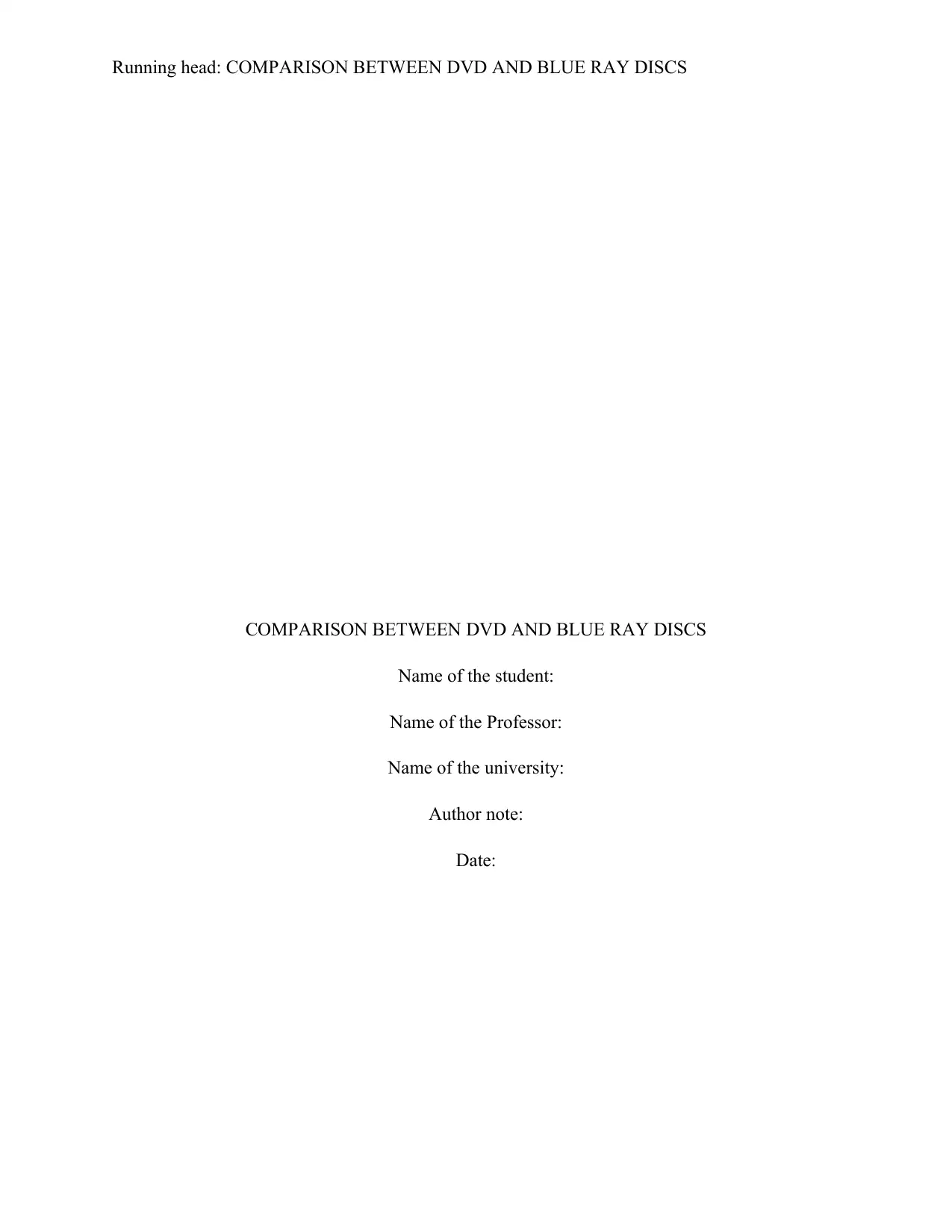
Running head: COMPARISON BETWEEN DVD AND BLUE RAY DISCS
COMPARISON BETWEEN DVD AND BLUE RAY DISCS
Name of the student:
Name of the Professor:
Name of the university:
Author note:
Date:
COMPARISON BETWEEN DVD AND BLUE RAY DISCS
Name of the student:
Name of the Professor:
Name of the university:
Author note:
Date:
Secure Best Marks with AI Grader
Need help grading? Try our AI Grader for instant feedback on your assignments.
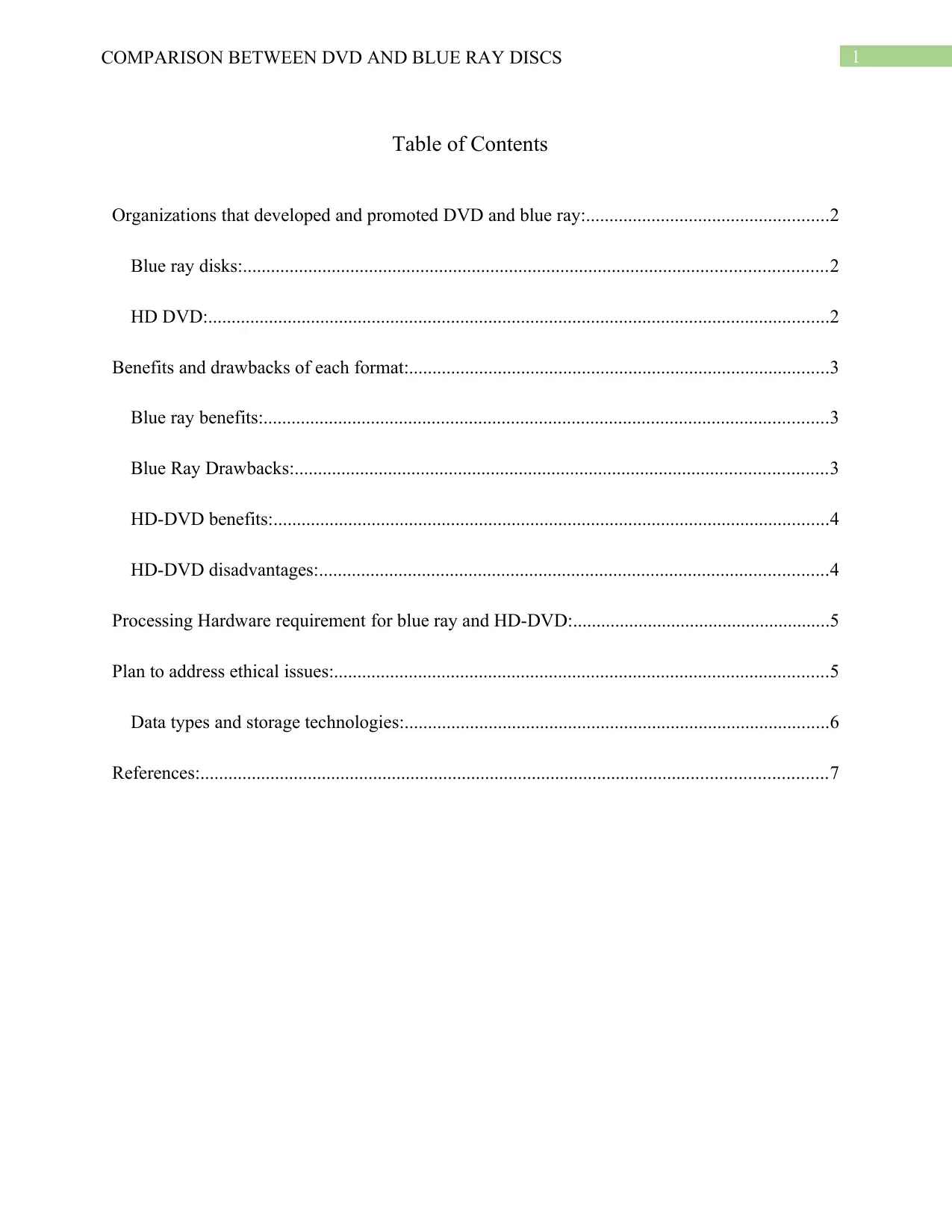
1COMPARISON BETWEEN DVD AND BLUE RAY DISCS
Table of Contents
Organizations that developed and promoted DVD and blue ray:....................................................2
Blue ray disks:.............................................................................................................................2
HD DVD:.....................................................................................................................................2
Benefits and drawbacks of each format:..........................................................................................3
Blue ray benefits:.........................................................................................................................3
Blue Ray Drawbacks:..................................................................................................................3
HD-DVD benefits:.......................................................................................................................4
HD-DVD disadvantages:.............................................................................................................4
Processing Hardware requirement for blue ray and HD-DVD:.......................................................5
Plan to address ethical issues:..........................................................................................................5
Data types and storage technologies:...........................................................................................6
References:......................................................................................................................................7
Table of Contents
Organizations that developed and promoted DVD and blue ray:....................................................2
Blue ray disks:.............................................................................................................................2
HD DVD:.....................................................................................................................................2
Benefits and drawbacks of each format:..........................................................................................3
Blue ray benefits:.........................................................................................................................3
Blue Ray Drawbacks:..................................................................................................................3
HD-DVD benefits:.......................................................................................................................4
HD-DVD disadvantages:.............................................................................................................4
Processing Hardware requirement for blue ray and HD-DVD:.......................................................5
Plan to address ethical issues:..........................................................................................................5
Data types and storage technologies:...........................................................................................6
References:......................................................................................................................................7
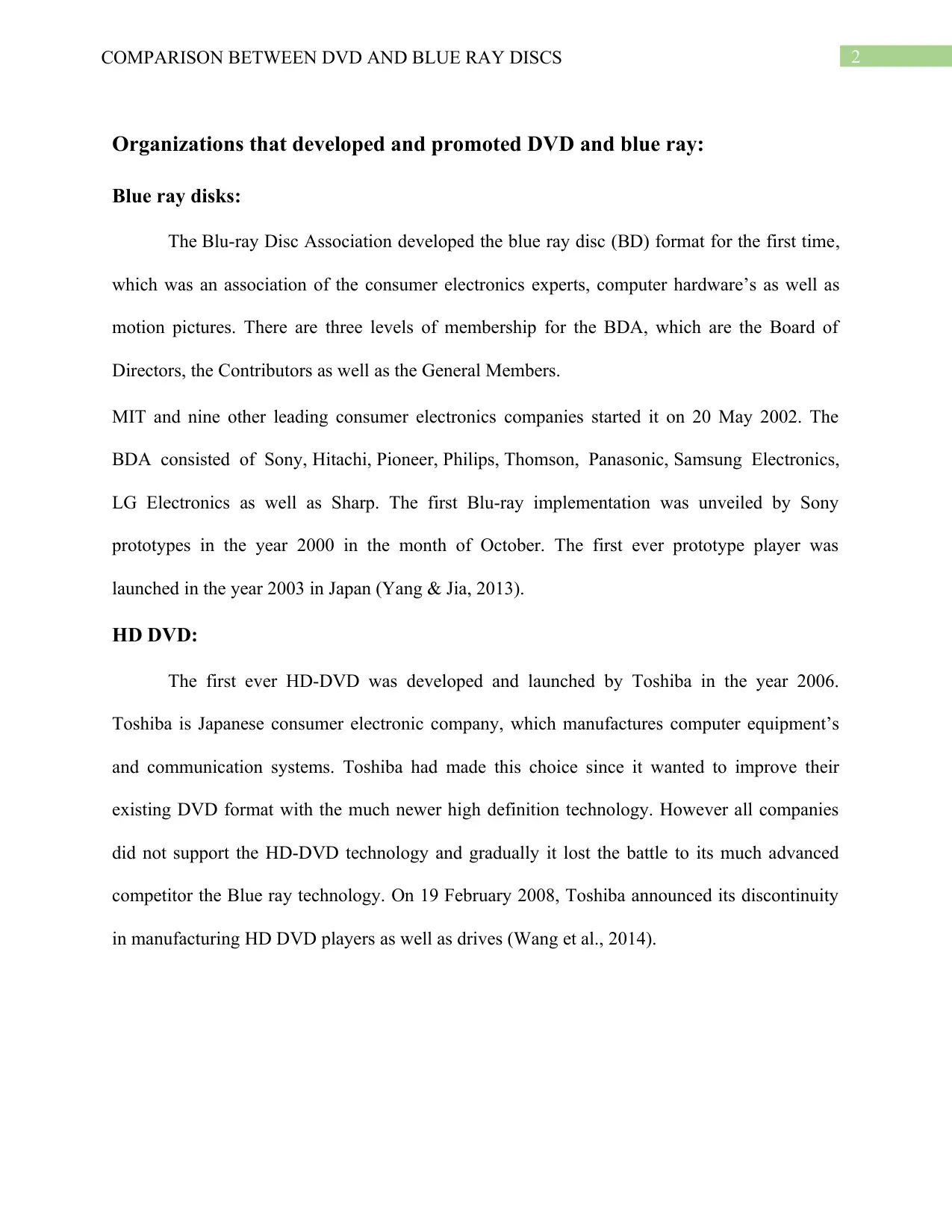
2COMPARISON BETWEEN DVD AND BLUE RAY DISCS
Organizations that developed and promoted DVD and blue ray:
Blue ray disks:
The Blu-ray Disc Association developed the blue ray disc (BD) format for the first time,
which was an association of the consumer electronics experts, computer hardware’s as well as
motion pictures. There are three levels of membership for the BDA, which are the Board of
Directors, the Contributors as well as the General Members.
MIT and nine other leading consumer electronics companies started it on 20 May 2002. The
BDA consisted of Sony, Hitachi, Pioneer, Philips, Thomson, Panasonic, Samsung Electronics,
LG Electronics as well as Sharp. The first Blu-ray implementation was unveiled by Sony
prototypes in the year 2000 in the month of October. The first ever prototype player was
launched in the year 2003 in Japan (Yang & Jia, 2013).
HD DVD:
The first ever HD-DVD was developed and launched by Toshiba in the year 2006.
Toshiba is Japanese consumer electronic company, which manufactures computer equipment’s
and communication systems. Toshiba had made this choice since it wanted to improve their
existing DVD format with the much newer high definition technology. However all companies
did not support the HD-DVD technology and gradually it lost the battle to its much advanced
competitor the Blue ray technology. On 19 February 2008, Toshiba announced its discontinuity
in manufacturing HD DVD players as well as drives (Wang et al., 2014).
Organizations that developed and promoted DVD and blue ray:
Blue ray disks:
The Blu-ray Disc Association developed the blue ray disc (BD) format for the first time,
which was an association of the consumer electronics experts, computer hardware’s as well as
motion pictures. There are three levels of membership for the BDA, which are the Board of
Directors, the Contributors as well as the General Members.
MIT and nine other leading consumer electronics companies started it on 20 May 2002. The
BDA consisted of Sony, Hitachi, Pioneer, Philips, Thomson, Panasonic, Samsung Electronics,
LG Electronics as well as Sharp. The first Blu-ray implementation was unveiled by Sony
prototypes in the year 2000 in the month of October. The first ever prototype player was
launched in the year 2003 in Japan (Yang & Jia, 2013).
HD DVD:
The first ever HD-DVD was developed and launched by Toshiba in the year 2006.
Toshiba is Japanese consumer electronic company, which manufactures computer equipment’s
and communication systems. Toshiba had made this choice since it wanted to improve their
existing DVD format with the much newer high definition technology. However all companies
did not support the HD-DVD technology and gradually it lost the battle to its much advanced
competitor the Blue ray technology. On 19 February 2008, Toshiba announced its discontinuity
in manufacturing HD DVD players as well as drives (Wang et al., 2014).
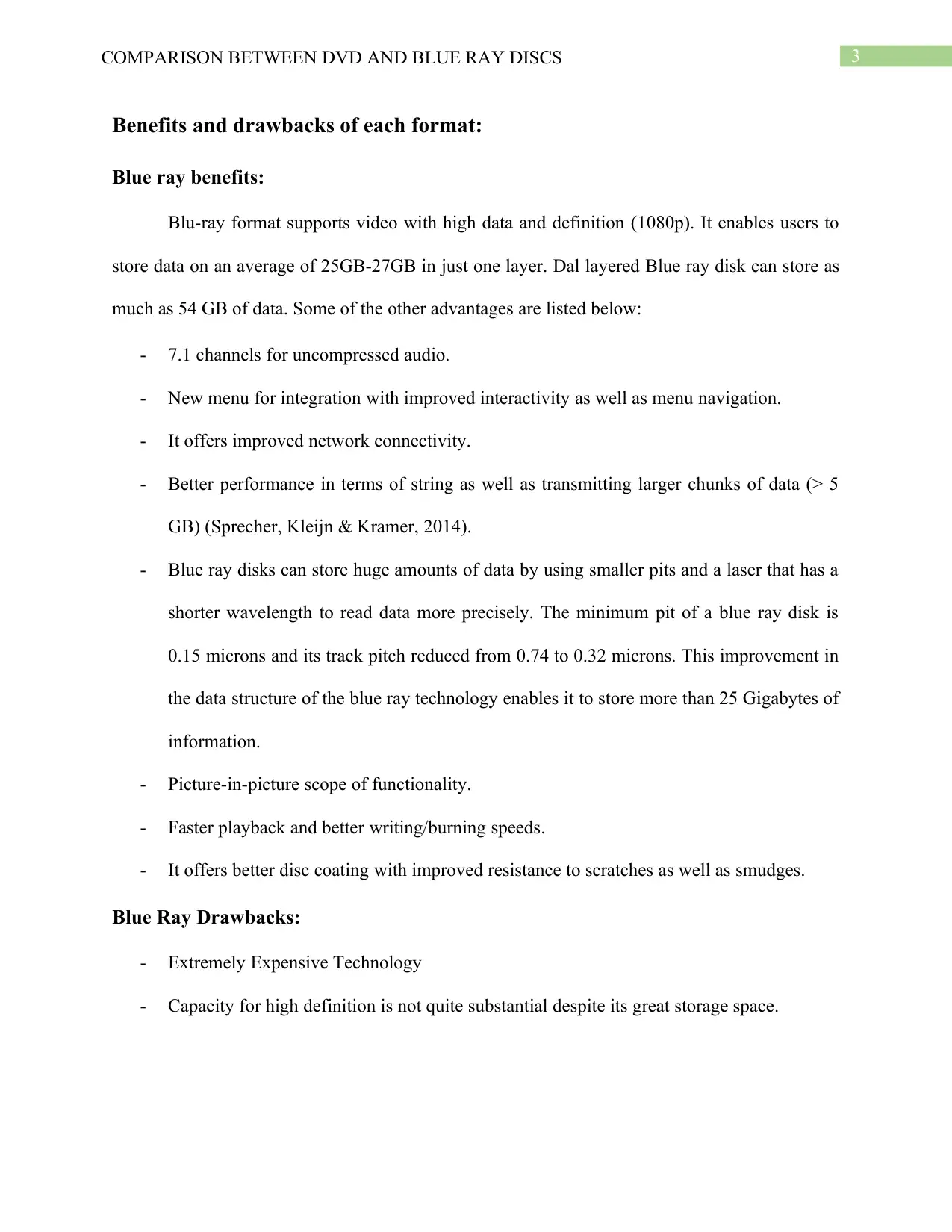
3COMPARISON BETWEEN DVD AND BLUE RAY DISCS
Benefits and drawbacks of each format:
Blue ray benefits:
Blu-ray format supports video with high data and definition (1080p). It enables users to
store data on an average of 25GB-27GB in just one layer. Dal layered Blue ray disk can store as
much as 54 GB of data. Some of the other advantages are listed below:
- 7.1 channels for uncompressed audio.
- New menu for integration with improved interactivity as well as menu navigation.
- It offers improved network connectivity.
- Better performance in terms of string as well as transmitting larger chunks of data (> 5
GB) (Sprecher, Kleijn & Kramer, 2014).
- Blue ray disks can store huge amounts of data by using smaller pits and a laser that has a
shorter wavelength to read data more precisely. The minimum pit of a blue ray disk is
0.15 microns and its track pitch reduced from 0.74 to 0.32 microns. This improvement in
the data structure of the blue ray technology enables it to store more than 25 Gigabytes of
information.
- Picture-in-picture scope of functionality.
- Faster playback and better writing/burning speeds.
- It offers better disc coating with improved resistance to scratches as well as smudges.
Blue Ray Drawbacks:
- Extremely Expensive Technology
- Capacity for high definition is not quite substantial despite its great storage space.
Benefits and drawbacks of each format:
Blue ray benefits:
Blu-ray format supports video with high data and definition (1080p). It enables users to
store data on an average of 25GB-27GB in just one layer. Dal layered Blue ray disk can store as
much as 54 GB of data. Some of the other advantages are listed below:
- 7.1 channels for uncompressed audio.
- New menu for integration with improved interactivity as well as menu navigation.
- It offers improved network connectivity.
- Better performance in terms of string as well as transmitting larger chunks of data (> 5
GB) (Sprecher, Kleijn & Kramer, 2014).
- Blue ray disks can store huge amounts of data by using smaller pits and a laser that has a
shorter wavelength to read data more precisely. The minimum pit of a blue ray disk is
0.15 microns and its track pitch reduced from 0.74 to 0.32 microns. This improvement in
the data structure of the blue ray technology enables it to store more than 25 Gigabytes of
information.
- Picture-in-picture scope of functionality.
- Faster playback and better writing/burning speeds.
- It offers better disc coating with improved resistance to scratches as well as smudges.
Blue Ray Drawbacks:
- Extremely Expensive Technology
- Capacity for high definition is not quite substantial despite its great storage space.
Secure Best Marks with AI Grader
Need help grading? Try our AI Grader for instant feedback on your assignments.
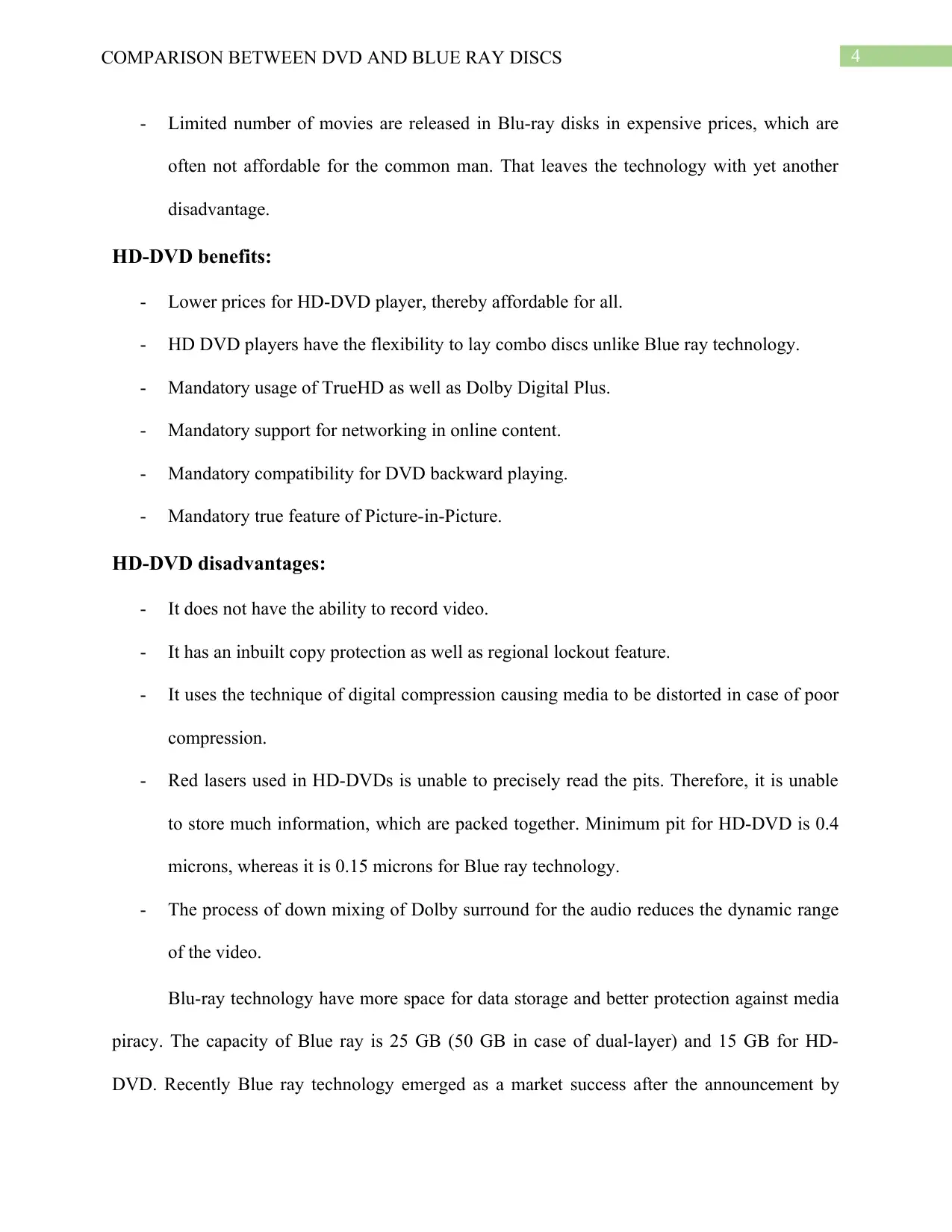
4COMPARISON BETWEEN DVD AND BLUE RAY DISCS
- Limited number of movies are released in Blu-ray disks in expensive prices, which are
often not affordable for the common man. That leaves the technology with yet another
disadvantage.
HD-DVD benefits:
- Lower prices for HD-DVD player, thereby affordable for all.
- HD DVD players have the flexibility to lay combo discs unlike Blue ray technology.
- Mandatory usage of TrueHD as well as Dolby Digital Plus.
- Mandatory support for networking in online content.
- Mandatory compatibility for DVD backward playing.
- Mandatory true feature of Picture-in-Picture.
HD-DVD disadvantages:
- It does not have the ability to record video.
- It has an inbuilt copy protection as well as regional lockout feature.
- It uses the technique of digital compression causing media to be distorted in case of poor
compression.
- Red lasers used in HD-DVDs is unable to precisely read the pits. Therefore, it is unable
to store much information, which are packed together. Minimum pit for HD-DVD is 0.4
microns, whereas it is 0.15 microns for Blue ray technology.
- The process of down mixing of Dolby surround for the audio reduces the dynamic range
of the video.
Blu-ray technology have more space for data storage and better protection against media
piracy. The capacity of Blue ray is 25 GB (50 GB in case of dual-layer) and 15 GB for HD-
DVD. Recently Blue ray technology emerged as a market success after the announcement by
- Limited number of movies are released in Blu-ray disks in expensive prices, which are
often not affordable for the common man. That leaves the technology with yet another
disadvantage.
HD-DVD benefits:
- Lower prices for HD-DVD player, thereby affordable for all.
- HD DVD players have the flexibility to lay combo discs unlike Blue ray technology.
- Mandatory usage of TrueHD as well as Dolby Digital Plus.
- Mandatory support for networking in online content.
- Mandatory compatibility for DVD backward playing.
- Mandatory true feature of Picture-in-Picture.
HD-DVD disadvantages:
- It does not have the ability to record video.
- It has an inbuilt copy protection as well as regional lockout feature.
- It uses the technique of digital compression causing media to be distorted in case of poor
compression.
- Red lasers used in HD-DVDs is unable to precisely read the pits. Therefore, it is unable
to store much information, which are packed together. Minimum pit for HD-DVD is 0.4
microns, whereas it is 0.15 microns for Blue ray technology.
- The process of down mixing of Dolby surround for the audio reduces the dynamic range
of the video.
Blu-ray technology have more space for data storage and better protection against media
piracy. The capacity of Blue ray is 25 GB (50 GB in case of dual-layer) and 15 GB for HD-
DVD. Recently Blue ray technology emerged as a market success after the announcement by
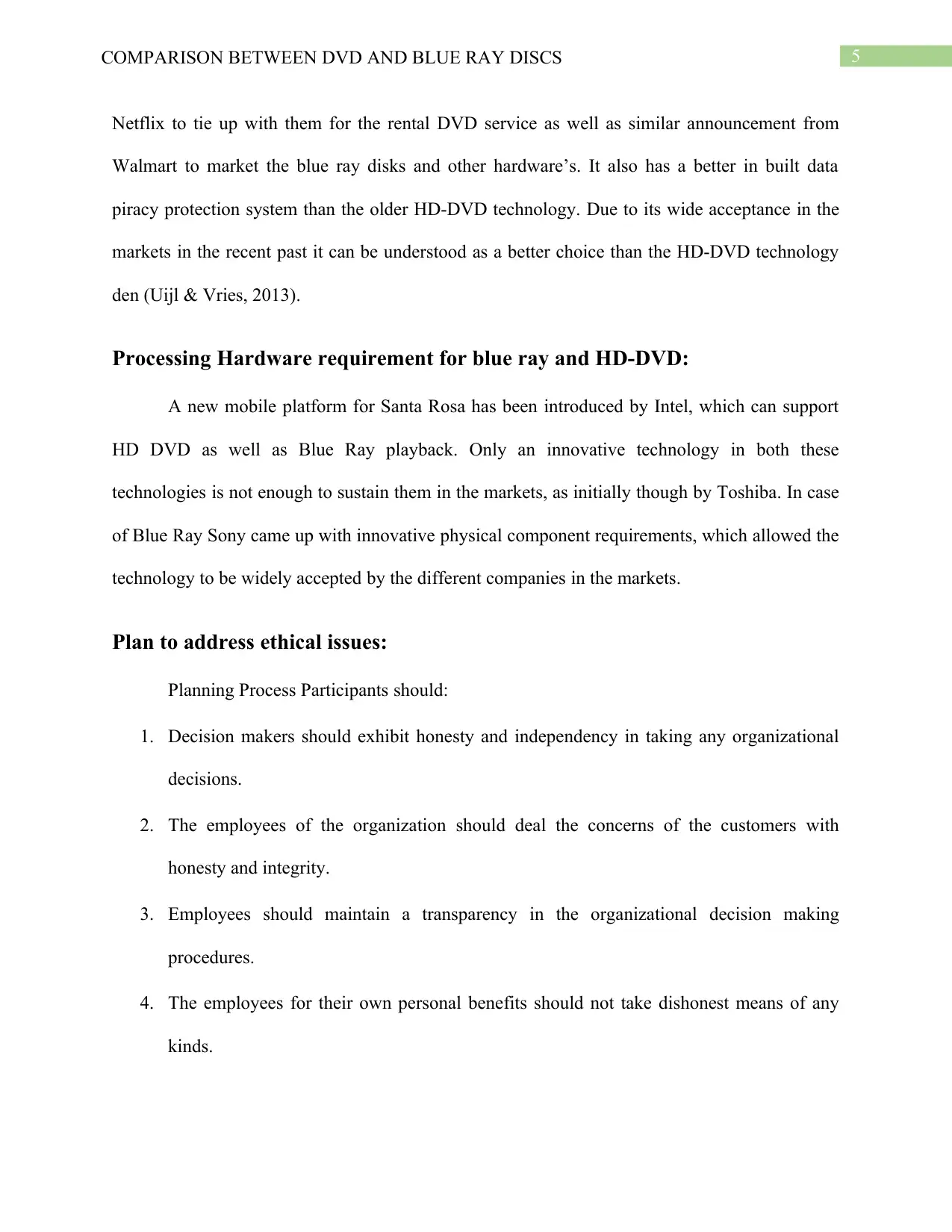
5COMPARISON BETWEEN DVD AND BLUE RAY DISCS
Netflix to tie up with them for the rental DVD service as well as similar announcement from
Walmart to market the blue ray disks and other hardware’s. It also has a better in built data
piracy protection system than the older HD-DVD technology. Due to its wide acceptance in the
markets in the recent past it can be understood as a better choice than the HD-DVD technology
den (Uijl & Vries, 2013).
Processing Hardware requirement for blue ray and HD-DVD:
A new mobile platform for Santa Rosa has been introduced by Intel, which can support
HD DVD as well as Blue Ray playback. Only an innovative technology in both these
technologies is not enough to sustain them in the markets, as initially though by Toshiba. In case
of Blue Ray Sony came up with innovative physical component requirements, which allowed the
technology to be widely accepted by the different companies in the markets.
Plan to address ethical issues:
Planning Process Participants should:
1. Decision makers should exhibit honesty and independency in taking any organizational
decisions.
2. The employees of the organization should deal the concerns of the customers with
honesty and integrity.
3. Employees should maintain a transparency in the organizational decision making
procedures.
4. The employees for their own personal benefits should not take dishonest means of any
kinds.
Netflix to tie up with them for the rental DVD service as well as similar announcement from
Walmart to market the blue ray disks and other hardware’s. It also has a better in built data
piracy protection system than the older HD-DVD technology. Due to its wide acceptance in the
markets in the recent past it can be understood as a better choice than the HD-DVD technology
den (Uijl & Vries, 2013).
Processing Hardware requirement for blue ray and HD-DVD:
A new mobile platform for Santa Rosa has been introduced by Intel, which can support
HD DVD as well as Blue Ray playback. Only an innovative technology in both these
technologies is not enough to sustain them in the markets, as initially though by Toshiba. In case
of Blue Ray Sony came up with innovative physical component requirements, which allowed the
technology to be widely accepted by the different companies in the markets.
Plan to address ethical issues:
Planning Process Participants should:
1. Decision makers should exhibit honesty and independency in taking any organizational
decisions.
2. The employees of the organization should deal the concerns of the customers with
honesty and integrity.
3. Employees should maintain a transparency in the organizational decision making
procedures.
4. The employees for their own personal benefits should not take dishonest means of any
kinds.
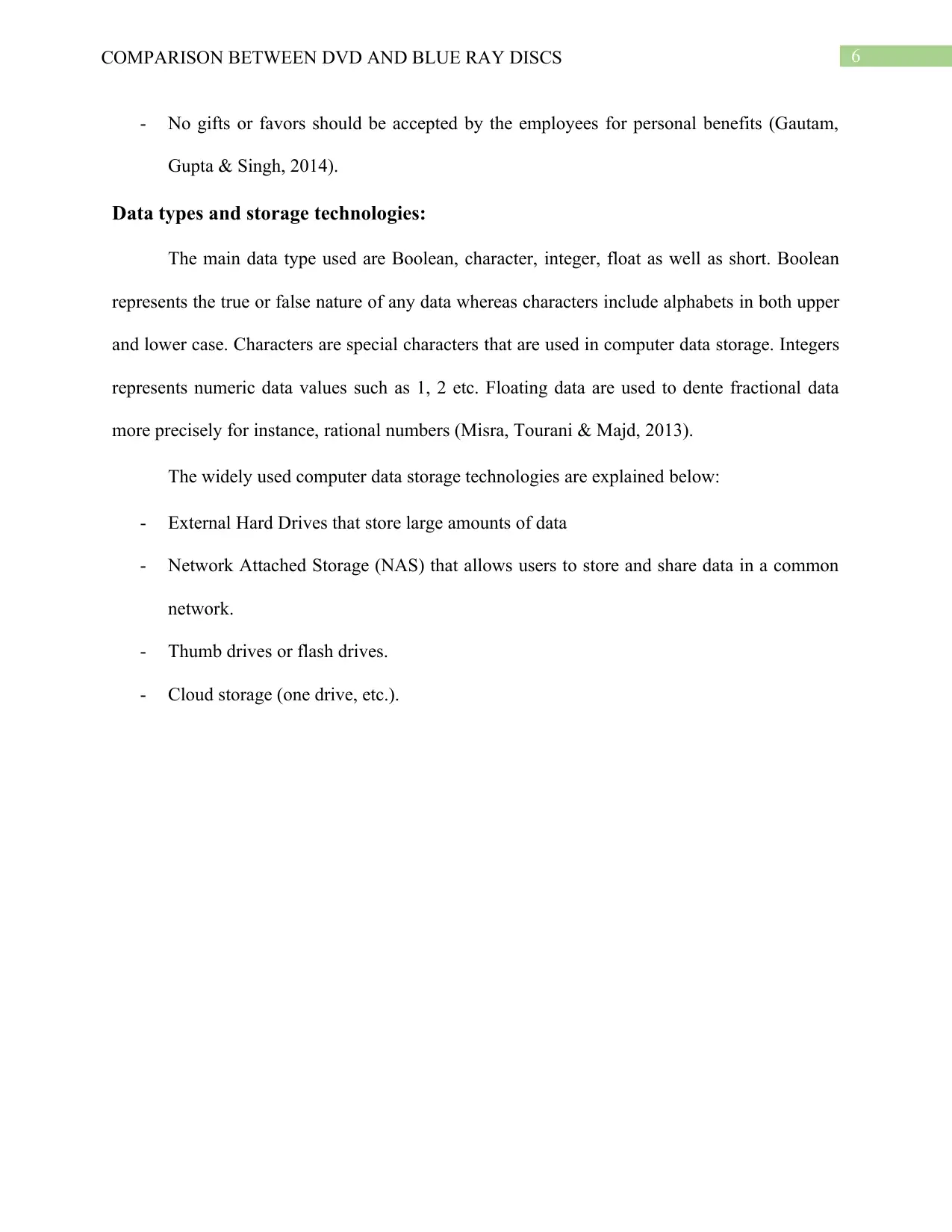
6COMPARISON BETWEEN DVD AND BLUE RAY DISCS
- No gifts or favors should be accepted by the employees for personal benefits (Gautam,
Gupta & Singh, 2014).
Data types and storage technologies:
The main data type used are Boolean, character, integer, float as well as short. Boolean
represents the true or false nature of any data whereas characters include alphabets in both upper
and lower case. Characters are special characters that are used in computer data storage. Integers
represents numeric data values such as 1, 2 etc. Floating data are used to dente fractional data
more precisely for instance, rational numbers (Misra, Tourani & Majd, 2013).
The widely used computer data storage technologies are explained below:
- External Hard Drives that store large amounts of data
- Network Attached Storage (NAS) that allows users to store and share data in a common
network.
- Thumb drives or flash drives.
- Cloud storage (one drive, etc.).
- No gifts or favors should be accepted by the employees for personal benefits (Gautam,
Gupta & Singh, 2014).
Data types and storage technologies:
The main data type used are Boolean, character, integer, float as well as short. Boolean
represents the true or false nature of any data whereas characters include alphabets in both upper
and lower case. Characters are special characters that are used in computer data storage. Integers
represents numeric data values such as 1, 2 etc. Floating data are used to dente fractional data
more precisely for instance, rational numbers (Misra, Tourani & Majd, 2013).
The widely used computer data storage technologies are explained below:
- External Hard Drives that store large amounts of data
- Network Attached Storage (NAS) that allows users to store and share data in a common
network.
- Thumb drives or flash drives.
- Cloud storage (one drive, etc.).
Paraphrase This Document
Need a fresh take? Get an instant paraphrase of this document with our AI Paraphraser
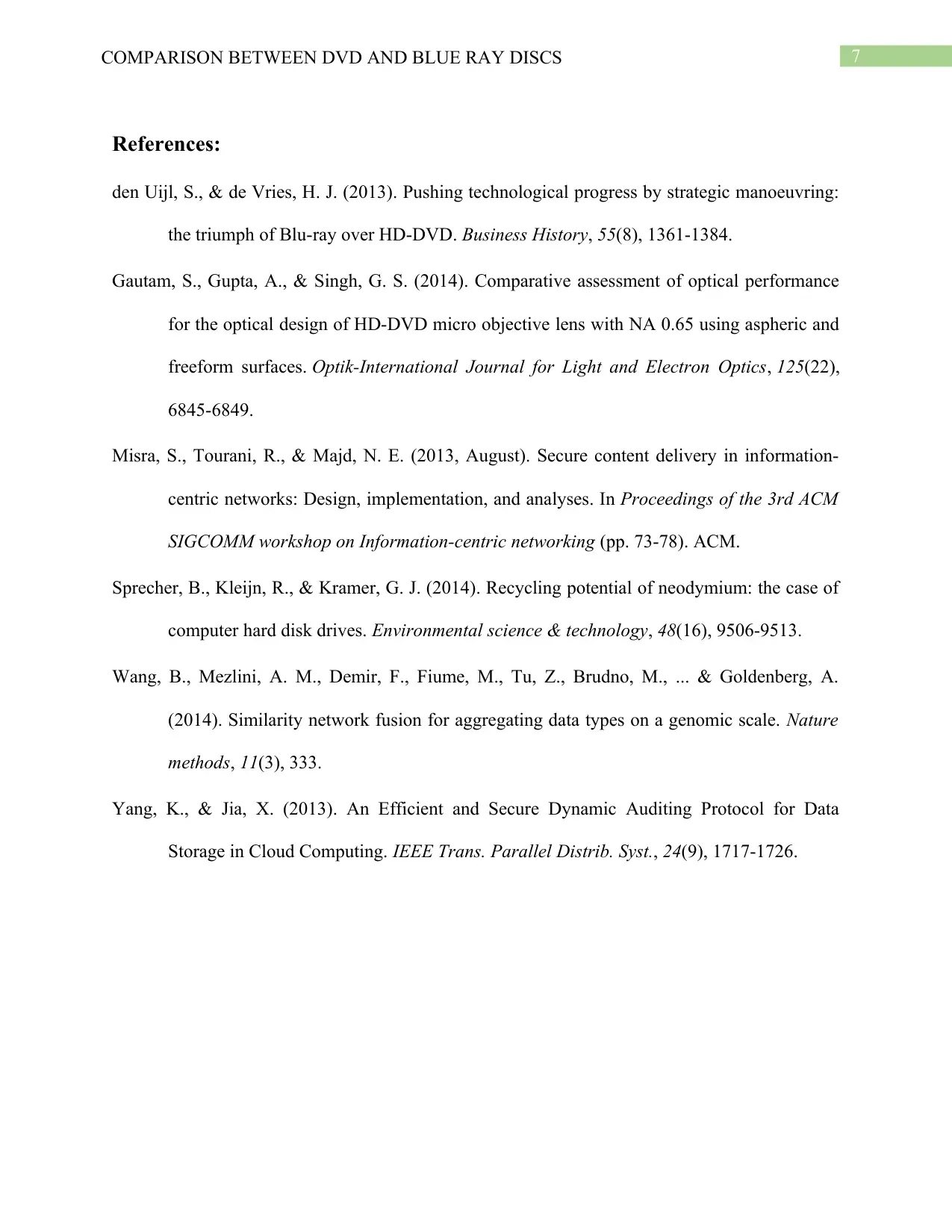
7COMPARISON BETWEEN DVD AND BLUE RAY DISCS
References:
den Uijl, S., & de Vries, H. J. (2013). Pushing technological progress by strategic manoeuvring:
the triumph of Blu-ray over HD-DVD. Business History, 55(8), 1361-1384.
Gautam, S., Gupta, A., & Singh, G. S. (2014). Comparative assessment of optical performance
for the optical design of HD-DVD micro objective lens with NA 0.65 using aspheric and
freeform surfaces. Optik-International Journal for Light and Electron Optics, 125(22),
6845-6849.
Misra, S., Tourani, R., & Majd, N. E. (2013, August). Secure content delivery in information-
centric networks: Design, implementation, and analyses. In Proceedings of the 3rd ACM
SIGCOMM workshop on Information-centric networking (pp. 73-78). ACM.
Sprecher, B., Kleijn, R., & Kramer, G. J. (2014). Recycling potential of neodymium: the case of
computer hard disk drives. Environmental science & technology, 48(16), 9506-9513.
Wang, B., Mezlini, A. M., Demir, F., Fiume, M., Tu, Z., Brudno, M., ... & Goldenberg, A.
(2014). Similarity network fusion for aggregating data types on a genomic scale. Nature
methods, 11(3), 333.
Yang, K., & Jia, X. (2013). An Efficient and Secure Dynamic Auditing Protocol for Data
Storage in Cloud Computing. IEEE Trans. Parallel Distrib. Syst., 24(9), 1717-1726.
References:
den Uijl, S., & de Vries, H. J. (2013). Pushing technological progress by strategic manoeuvring:
the triumph of Blu-ray over HD-DVD. Business History, 55(8), 1361-1384.
Gautam, S., Gupta, A., & Singh, G. S. (2014). Comparative assessment of optical performance
for the optical design of HD-DVD micro objective lens with NA 0.65 using aspheric and
freeform surfaces. Optik-International Journal for Light and Electron Optics, 125(22),
6845-6849.
Misra, S., Tourani, R., & Majd, N. E. (2013, August). Secure content delivery in information-
centric networks: Design, implementation, and analyses. In Proceedings of the 3rd ACM
SIGCOMM workshop on Information-centric networking (pp. 73-78). ACM.
Sprecher, B., Kleijn, R., & Kramer, G. J. (2014). Recycling potential of neodymium: the case of
computer hard disk drives. Environmental science & technology, 48(16), 9506-9513.
Wang, B., Mezlini, A. M., Demir, F., Fiume, M., Tu, Z., Brudno, M., ... & Goldenberg, A.
(2014). Similarity network fusion for aggregating data types on a genomic scale. Nature
methods, 11(3), 333.
Yang, K., & Jia, X. (2013). An Efficient and Secure Dynamic Auditing Protocol for Data
Storage in Cloud Computing. IEEE Trans. Parallel Distrib. Syst., 24(9), 1717-1726.
1 out of 8
Your All-in-One AI-Powered Toolkit for Academic Success.
+13062052269
info@desklib.com
Available 24*7 on WhatsApp / Email
![[object Object]](/_next/static/media/star-bottom.7253800d.svg)
Unlock your academic potential
© 2024 | Zucol Services PVT LTD | All rights reserved.